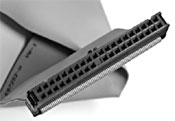What Is IDE and What Does It Mean To Your Computer?
IDE stands for Integrated Drive Electronics and is an established standard for connecting hard drives or CD-ROM drives in home computers. IDE was and is part of the ATA (Advanced Technology Attachment) standard which encompased the IDE, E-IDE, ATAPI and SATA standards that we've all come to know. The introduction of Serial ATA forced a slight rename in the old ATA devices for them to become Parallel ATA (PATA).
Before Western Digital released the early version of IDE computer users were accustomed to having a hard drive and a separate drive controller (in the form of an expansion) card. These were cumbersome to configure and tended to lead to a mess of cabling. IDE combined the drive and the hard drive controller into one single unit - this particular move met with widespread favor from computer users all over the world.
The original IDE standard only supported hard drives up to 528MB in capacity. To get over this  hurdle (as massive hard drives became the norm) the E-IDE (Enhanced IDE) standard was introduced to allow the support of far, far larger hard drives.
hurdle (as massive hard drives became the norm) the E-IDE (Enhanced IDE) standard was introduced to allow the support of far, far larger hard drives.
In any computer system IDE drives work in a master - slave configuration and then only two such pairs are supported on the vast majority of motherboards for a maximum of 4 drives per system (including CD and DVD drives which rely on the ATA interface). IDE has served millions of computer users very well for almost decades now but SATA is slowly taking over.